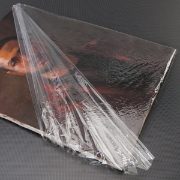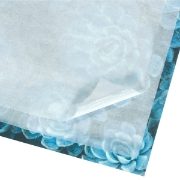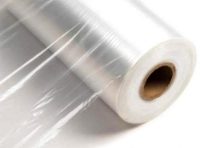Dartek Vs Glassine
Dartek Vs
Glassine, you’ll not be watching this particular matchup on a pay per view sports channel, but weighing up your options for wrapping or storing artwork may present this quandary.
Those who know both materials will know that they are distinctly different, yet both are used for many of the same applications, and in this lies the core of the issue - When you have two materials which are so different, which one should you use?
What is Dartek?
Dartek is a cast film made from nylon 6,6. if you were to compare it to commonly known materials, it feels somewhere in between a thin polyester film (Mylar to some) and common-or-garden cling film. But cling film or polyester it is not. Although Dartek is much softer and more pliable than polyester, it’s also resistant to tearing or puncturing and has good release properties. It is totally smooth to the touch and has no plasticisers, additives or surface coatings, making it ideal for storage and transport.
 There are a few variants of Dartek, the one most commonly used in conservation (and the one we stock) is C-917, this is archival standard, and is heat stabilised. Being heat stabilised, and with good release properties, makes it ideal for use as a membrane on vacuum hot tables when lining paintings. With a melting point of 266°C, Dartek can be welded to itself or other materials using a tacking iron, meaning pockets or envelopes can be formed. It’s a great material for creating dust covers and will stretch, unlike polyester.
There are a few variants of Dartek, the one most commonly used in conservation (and the one we stock) is C-917, this is archival standard, and is heat stabilised. Being heat stabilised, and with good release properties, makes it ideal for use as a membrane on vacuum hot tables when lining paintings. With a melting point of 266°C, Dartek can be welded to itself or other materials using a tacking iron, meaning pockets or envelopes can be formed. It’s a great material for creating dust covers and will stretch, unlike polyester.
Dartek will absorb moisture, this can be seen in action if you place a small piece of it on your hand. If you are aware of the fortune telling fish that are common in Christmas crackers in the UK, Dartek behaves in a similar fashion. The hydroscopic material absorbs the moisture from your palm and begins to swell, causing the material to curl. Watch the video below to see what we mean. This behaviour makes Dartek more pliable when humidified.
What is Glassine?
Glassine is a smooth translucent paper that is thin but also strong, even though it is only 40gsm. It is less expensive than Dartek and can can be used for a variety of purposes.
Glassine has a shiny finish to both sides and feels like a soft, light, grease-proof paper. In conservation it is generally used where its translucency is valuable, allowing prints or paintings to be viewed without handling directly.
Glassine can vary drastically in quality between manufacturers and when used in conservation, clarity is usually a key feature which can be lost in cheaper paper. Glassine is ‘calendered’ several times in order to achieve the smooth finish and thinness, ours has been selected to offer the best quality combined with a neutral pH of around 7 (unbuffered).

In damp conditions Glassine can bond with photographs and negatives with a gelatin emulsion, so is generally not recommended for this purpose in archival storage as it can cause irreparable damage. It may also stick to paintings which have not fully dried, again, it is generally not recommended for this purpose when packing or storing. Glassine is a paper and as such can become creased, causing abrasions on stored artwork in the long term. Having said this, Glassine doesn’t wrinkle or cockle as easily as other tissues can, and due to this is superior to tissue paper for interleaving.
So, What material should I use? Dartek or Glassine?
This would of course depend upon what it is that you’re planning to do. We always advise speaking to qualified conservator before buying any products that you’re not sure about. But here are a few pointers:

- Dartek is considered better for temporary wrapping of paintings that have not fully dried (i.e. oils, mixed media etc) as it will not adhere readily to the art as Glassine or tissue paper can
- Dartek is completely transparent, excellent for protection of artwork which still needs to be viewed. If using for archival storage, additional protection from UV light might be necessary
- Dartek C-917 is stable when heated, making it useful on vacuum hot tables when lining paintings
- Dartek is very pliable, can stretch, and can be welded (heat increases its flexibility) and is ideal for creating dust covers
- Due to its flexibility and resistance to tearing, Dartek can be used to wrap sculptures and other irregular shaped objects
- Dartek is available in roll widths of up to 2235mm for larger items
- Dartek is resistant to water, oil, chemicals and vapour

- Glassine is less expensive than Dartek
- Glassine is more resilient than tissue paper, it will not tear as easily, won’t cockle as easily and provides a higher level of transparency when used for interleaving
- Glassine is unbuffered and of a neutral pH of around 7
- Glassine is available in sheet form as well as rolls for ease of use and can be easily creased and cut to form enclosures
- Glassine can crease and abrade objects and is not recommended for long term storage of photographs or negatives as it can adhere to photographic emulsion when damp
- Glassine can vary in quality between manufacturers
Glassine is used by many for archival storage, its application is one that divides opinion in conservation, a qualified conservator would be best placed to advise whether it is suitable for any specific use. Glassine is a relatively low-cost material that is very good for interleaving, superior to most other papers and tissues for this purpose. The fact that it is unbuffered might make it more suitable than buffered alternatives for specific items.
When wrapping a work of art, Dartek is generally a better material than Glassine given that it will not bond as readily with any surfaces, particularly oil paints. Other solutions for wrapping art would be silicone coated paper or silicone coated polyester which will not adhere to the surface of the paint. For sculptures, framed art, or other irregular shaped objects, Tyvek presents another protective covering option. Dartek is the most pliable of these materials, and is transparent, which might influence your final decision.
The ideal long-term storage environment for works of art on paper is one where nothing is in contact with the surface of the art, this can be achieved for example; by framing, or matting prints. These can then be safely wrapped in Dartek for storage or shipping. Polyester is totally inert and can be used as a long-term interleaving material or enclosure.
Would you like to see them for yourself?
Order a free sample of Dartek and/or Glassine on their respective pages below and see what you think:
Dartek Here -
Dartek
Glassine Here -
Glassine
Samples are free with any order, if ordered without other products a postage charge will apply.